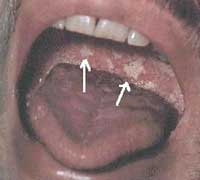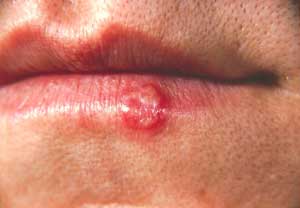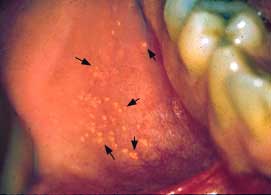Oral-Pharyngeal Candidiasis – Commonly occurs in newborns due to exposure to fungi from the mother during childbirth, presenting as white patches that can be scraped off soft tissues, often accompanied by inflammation and petechiae.
 |
|
Oral Candidiasis |
Diagnosis is based on direct microscopic examination of samples or cultures taken from lesions. Oral-pharyngeal candidiasis typically resolves on its own in healthy infants; in cases where the condition persists, treatment with nystatin or fluconazole can expedite recovery and reduce the risk of transmission.
Oral-pharyngeal candidiasis is also a significant issue in treating bone marrow failure. Systemic candidiasis often arises and can be fatal in patients undergoing bone marrow failure treatment, and it is nearly unavoidable in patients with existing oral-pharyngeal, esophageal, or intestinal candidiasis. A combined treatment of 0.2% chlorhexidine solution and fluconazole is effective in preventing oral-pharyngeal candidiasis in pediatric bone marrow transplant patients, thus minimizing the risk of oral-pharyngeal and systemic candidiasis.
Aphthous Ulcers
Aphthous ulcers are specific lesions in the mouth that tend to recur. They are noted to affect about 20% of the population, appearing as well-defined ulcers with a necrotic white base surrounded by a red inflammatory halo. These lesions persist for 10-14 days and heal spontaneously without leaving scars.
Herpetic Gingivostomatitis
After an incubation period of approximately one week, individuals infected with the herpes virus begin to exhibit symptoms such as fever and fatigue. The oral cavity may show varying degrees of symptoms, including swollen red gums and scattered small vesicles throughout the mouth. These symptoms typically resolve within two weeks without scarring. Hydration may be necessary if the child is dehydrated, and mouth rinses that alleviate pain and reduce fever can provide comfort.
Recurrent Herpes Labialis
 |
|
Recurrent Herpes Labialis (Photo: pathmicro) |
About 90% of people have antibodies against the herpes simplex virus. Unlike primary gingivostomatitis caused by herpes, recurrent herpes lesions are usually localized to the lips. In addition to painful vesicles and atypical symptoms, recurrent herpes labialis typically does not present with systemic symptoms. Antiviral medications are generally less effective than symptomatic treatments for healthy patients experiencing recurrent herpes.
Bohn Nodules
Bohn nodules appear in newborns as congenital nodules located in the oral cavity and on the tongue at the alveolar ridge of the upper and lower jaws and the hard palate. These lesions form from remnants of the epithelial tissue of mucous glands. Bohn nodules do not require treatment and typically resolve within a few weeks.
Dental Lamina Cysts
These small cysts appear in newborns along the gingival ridges of the upper and lower jaws. They are formed from remnants of the dental lamina. Dental lamina cysts do not require treatment and usually disappear within a few weeks.
Fordyce Granules
 |
|
Fordyce Granules on Tongue (Photo: dental) |
Approximately 80% of adults have small, white or yellow granules that form clusters on the oral mucosa, primarily on the lips and inner cheeks. These are abnormal sebaceous glands that appear at birth, may enlarge, and initially present as yellowish patches; they occur in about 50% of children. Fordyce granules do not require treatment.
Gingival Abscess
A gingival abscess presents as a soft, red lump near the roots of teeth affected by chronic dental abscesses. Gingival abscesses are usually located where the dental abscess would drain pus. Treatment primarily involves accurately diagnosing the affected tooth for extraction or endodontic treatment.
Chapped Lips
Commonly seen in children, chapped lips manifest as dry lips, followed by crusting and cracking, accompanied by a burning sensation. This condition is often caused by allergic reactions to contact substances (toys or food) or sun exposure. It worsens when saliva reduces moisture and is exacerbated by wind, especially in cold weather. Chapped lips often accompany fever. Regular application of a thin gel helps accelerate healing and prevent the condition.
Tongue-Tie
Characterized by a short lingual frenulum that restricts tongue movement. The frenulum elongates as the child grows. If the severity of tongue-tie significantly impacts speech activities, surgical intervention may be indicated.
Geographic Tongue
Usually benign and clinically insignificant, geographic tongue manifests as one or more bright red, flat areas bordered by white, yellow, or gray lines, set against a background of normal red tongue tissue. The etiology is unclear, and there are no treatment indications.
Fissured Tongue
Clinically characterized by multiple small fissures or grooves on the dorsal surface of the tongue. If painful, treatment may involve cleaning the tongue or rinsing to reduce bacterial load in the grooves.
Dr. PHAM HONG DUC (Melbourne, Australia)


















































